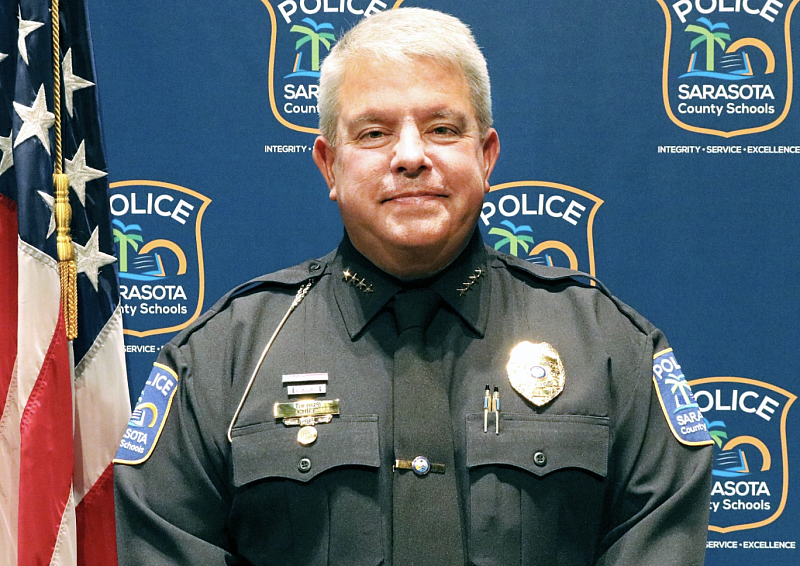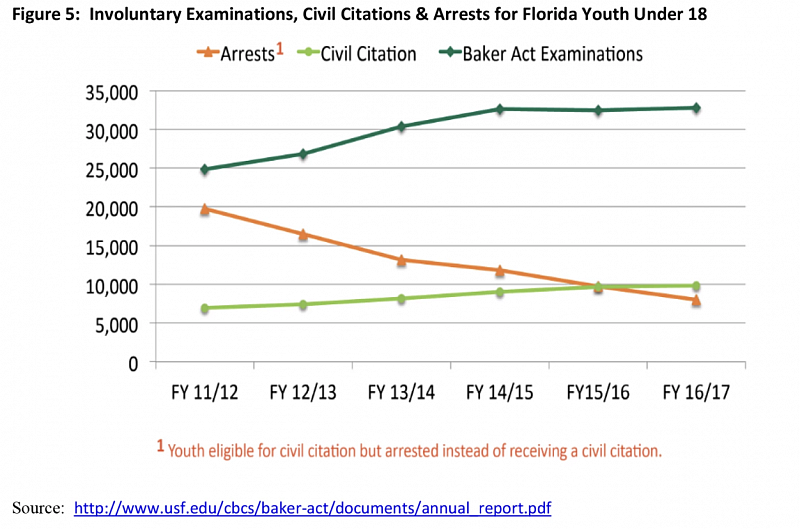The Baker Act wasn’t designed for kids, yet the number of children being sent for involuntary psychiatric evaluations has continued to go up. State data shows schools make up nearly a quarter of all origin points for Baker Act referrals.
Fear of school shootings and increased pressure to regulate student behavior mean one bad joke can plunge a child, and their family, into the state's mental health system. Beth Carr and her son Chris, discovered this the hard way in December 2016.
A Bad Joke Leads To A Baker Act
Chris Carr was in a physical education class. The teacher was discussing drug abuse, talking about inhalants.
“And on the list of inhalants is gasoline," Beth Carr recounted. "And my son was like 'Oh, I like the smell of gasoline.' Right? You know how kids are. They just say things. And his teacher was like, ‘Oh, you know who else likes the smell of gasoline? Sociopaths.”
Today, Chris Carr is a college student. He graduated from high school in May.
Four years ago when he was a freshman, what he thought was a joke, became a serious problem. After the snarky comment about liking the smell of gas, Chris was pulled out of class by two school resource officers — local sheriff’s deputies, Beth Carr said. Chris’ teacher had referred Chris to them.
“And they’re asking him questions [for about] 15 to 20 minutes I would think. And if he thought about killing people, if he owned any guns, if there were guns accessible in the house … and these leading kinds of questions … and of course, he’s answering them,” Beth Carr said.
She says officers pressed Chris for answers. He said yes, there were guns in the house but he didn’t know where they were or how to use them. He told officers he didn’t want to kill anyone, but when officers pressed, and asked how he would do it if he did, Chris said he supposed poisoning food could work. The result: Chris was taken for psychiatric evaluation under the Baker Act.
“They decided he was homicidal and needed to be Baker Acted," said Beth Carr. "And it wasn’t until he was well on his way to the facility, that I got the phone call."
She thought the call from the school was a bad joke, Carr said. She still gets emotional when she tells this story of how her son had no adult present. How he was taken away in the back of a police car. How she raced to get to the facility and intercede. How, when she got there, panicked and upset, her 15-year-old son started bawling.
“He was scared. He was upset," Beth Carr said. "He didn’t know what happened. He couldn’t understand what happened.”
The Baker Act and the Risk of Inaction
In Florida, law enforcement initiates more than half of all referrals under the Baker Act. In rural areas, where medical and mental health services are scarce, the figures are far higher.
Tim Enos is head of the Florida Association of School Resource Officers. He worked with kids and schools for nearly 20 years. He knows what it's like to miss a sign and fail a kid, Enos said.
He experienced two separate incidents involving two 14-year-old girls who tried to take their own lives.
One of the two girls lived. The other did not.
“You never ever want to be the person who decided and erred," Enos said. "Because you think of, what if you erred and you didn’t help that student, and something tragic [happened]? You can imagine the amount of guilt you’d feel for the rest of your life that you had an opportunity to help somebody and you didn’t.”
Kids are hurting and school is where that hurt becomes obvious because it’s a safe space, Enos said.

"It’s one thing to go home and plan to do something, it’s another to go to school …because there’s an immediacy [there]," Enos said. "There've been two incidents in my career at school that were traumatic for everyone involved. You think about kids being resilient, but how much pressure are they under for them to think this was their only way out? That’s really sad.”
That’s why school resource officers don’t take chances, Enos said. It’s why a bad joke can escalate into something more.
The rise in school shootings, such as the one that happened in Parkland in 2018, also has school and law enforcement officials on edge. No one wants to risk being wrong. The cost of that, he said, outweighs everything else.
Beth Carr said she gets it, but wishes officers, the teachers and the school had exercised a bit more discretion when it came to her son.
Sometimes, there’s a lot of blame after a child is committed. Some say, it’s the fault of overzealous police. Others say, it’s the fault of schools. Many blame a lack of funding and a convoluted law. So is there a villain?
“That’s a very good question," Beth Carr said. "You know, my instinct about people is that most people do things with the best intentions.”
Carr’s son Chris stayed overnight at the facility and was released the next day when a psychologist determined he didn’t meet the criteria to be committed. A 2017 task force report on the Baker Acting of children found a third of them were unnecessary.
As Juvenile Arrests Fall, Baker Acts Rise
State data shows the Baker Act has had other unintended consequences. Several years ago, the state began trying to decrease the number of children being arrested. In recent years, instead of referring kids to the Department of Juvenile Justice, law enforcement has switched to juvenile citations in an effort to curb the school-to-prison pipeline. But something else has emerged. As the number of Department of Justice referrals has gone down, the number of kids being Baker Acted has risen. It's something the state has noted. And though state officials said they cannot be certain of whether there is a relationship, several state reports show the correlation.

Some of the experts interviewed by WFSU for this story said sometimes the Baker Act is the less invasive approach.
But the Baker Act was always meant to be the last resort, said Mimi Graham, director of Florida State University’s Center for Prevention and Early Childhood Intervention.
“That’s who the Baker Act was intended for — the guy walking naked down Tennessee Street and talking about Jesus and the coming of the Lord in 30 degree weather," she said.
A Mother's Fear
Chris Carr went back to school. He made friends, joined the choir, and didn’t have any other issues. Yet to this day, he doesn’t talk about his experience. The family doesn't either.
What would they say, Beth Carr said. Mental health carries a stigma, and she doesn't want her son to be seen as mentally ill. When the school committed Chris under the Baker Act, Carr thought she and her family were an outlier. Now, she knows they are not.
"[Families]' are terrified," she said. "They don't want [others] to know. There's this stigma attached to it, right? Because there are so many people out there who will just automatically go along with 'Oh, he was Baker Acted, so it must be true'."
Carr now worries about how having a Baker Act referral on her son's medical record will affect his future career choices.
“What they did was damaging," she said. "This is on my son's health record for life."
Her biggest fear, she said, is that it could happen again. That her son, being snarky, will say the wrong thing to the wrong person.
"Unfortunately, it’s in the gene pool. We’re all snarky," she said. "And that’s my biggest fear."
And until something changes, it could happen to other kids as well.
Coming up: Part four of this series explores how some schools are taking a different approach in addressing mental health and the underlying trauma that often leads to referrals under the Baker Act.
This article was conceived and produced as a project between WFSU News and Health News Florida for the Fund for Journalism on Child Well-Being, a program of the USC Annenberg Center for Health Journalism’s 2020 National Fellowship.
[This story was originally published by WFSU Public Media.]


